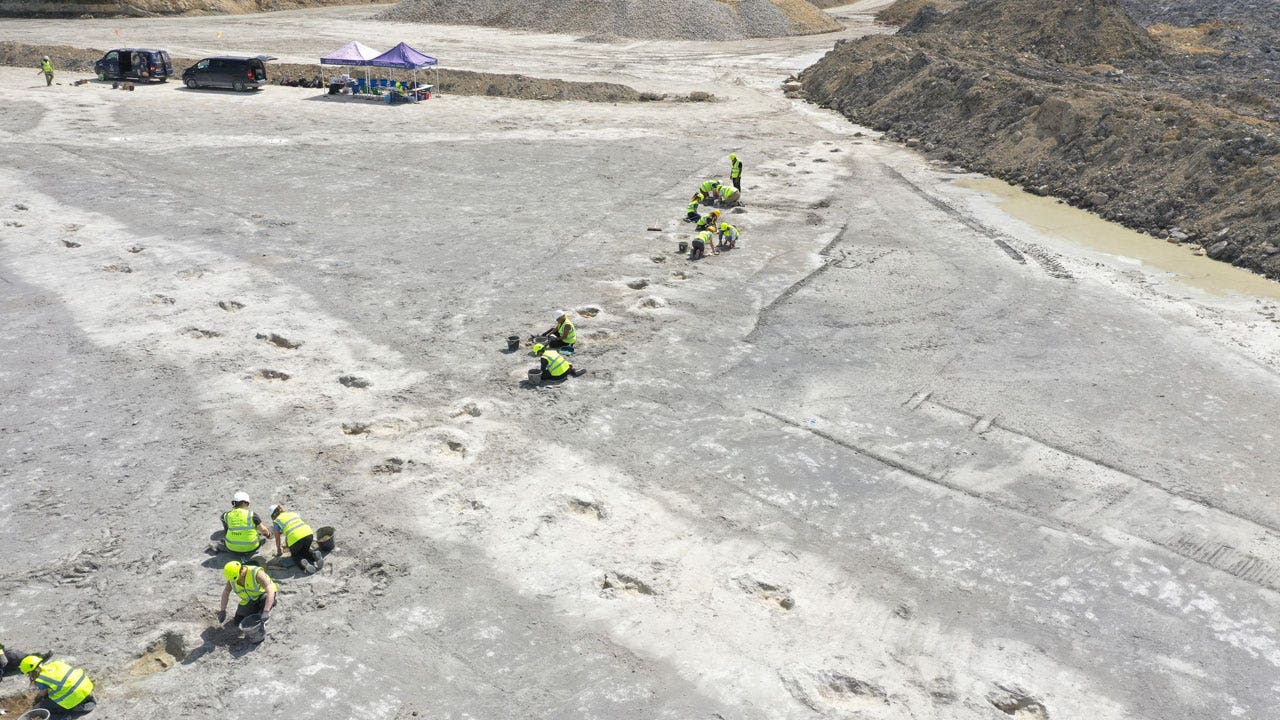Physical Address
304 North Cardinal St.
Dorchester Center, MA 02124
Physical Address
304 North Cardinal St.
Dorchester Center, MA 02124

A worker extracting clay from a limestone quarry in southern England noticed unusual irregularities that led to the discovery of a “dinosaur highway” and nearly 200 footprints dating back 166 million years, researchers said Thursday.
The unusual find, made after a team of more than 100 excavated the Dewars Farm quarry in Oxfordshire in June, expands on previous works on paleontology Researchers from the Universities of Oxford and Birmingham said it was in the area and offered the best insight into the Middle Jurassic period.
FIRST-EVER GREEN DINOSAUR SKELETON RECOVERED IN UTAH MAY BE NEW SPECIES, NATIONAL GEOGRAPHIC SAYS
“These traces offer an extraordinary window into the the life of dinosaursrevealing details about their movements, interactions and the tropical environment they inhabited,’ said Kirsty Edgar, professor of micropaleontology at the University of Birmingham.

Workers gather around the five wide tracks that form part of the ‘dinosaur highway’ at the Dewars Farm quarry in Oxfordshire, England. (University of Birmingham via AP)
Four of the sets of tracks that make up the so-called highway show the paths taken by giant, long-necked herbivores called sauropods, which are believed to be Cetiosaurus, a dinosaur that grew to nearly 60 feet in length. The fifth set belonged to Megalosaurus, a ferocious 30-foot-long predator that left a distinctive three-claw imprint and was the first dinosaur to be given a scientific name two centuries ago.
Where the tracks intersect raises questions about possible interactions between carnivores and herbivores.

“Scientists have known and studied megalosaurs longer than any other dinosaur on Earth, and yet these recent discoveries prove that there is more evidence of these animals waiting to be discovered,” said Emma Nicholls, Vertebrate Paleontologist at the Museum. of Natural History from Oxford University.
Almost 30 years ago, 40 sets of tracks found in a limestone quarry in the area were considered one of the most scientifically important dinosaur footprint sites in the world. But the area is now largely inaccessible and there is limited photographic evidence because it was before digital cameras and drones were used to record finds.

Workers carefully study the dinosaur tracks found in the Dewars Farm quarry in Oxfordshire, England. (Emma Nichols/OUMNH via AP)
A team working on site this summer took more than 20,000 digital images and used drones to create 3D models of the prints. The wealth of documents will aid future research and may shed light on the size of dinosaurs, how they walked and the speed at which they moved.
CLICK HERE TO SUBSCRIBE TO OUR LIFESTYLE NEWSLETTER
“The preservation is so detailed that we can see how the mud was deformed as the dinosaur’s feet squished in and out,” said Duncan Murdoch, a geologist at the Oxford Museum. “Together with other fossils such as burrows, shells and plants, we can bring to life the muddy lagoon where the dinosaurs walked.”
The finds will be featured in a new exhibition at the museum and will also feature on the BBC’s Dig for Britain program next week.